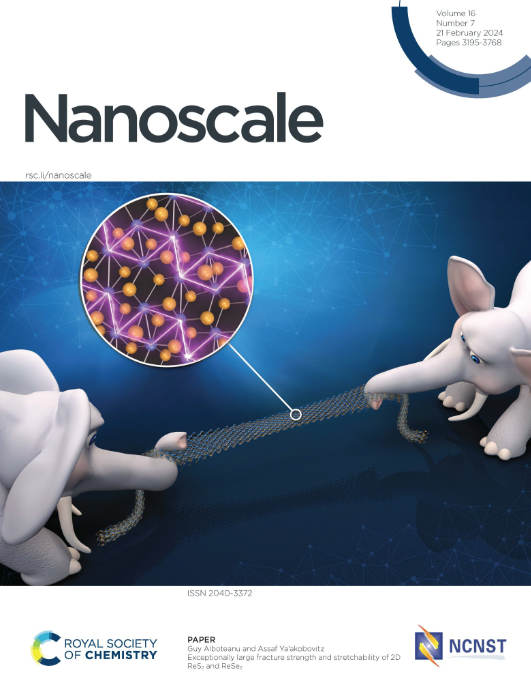坚韧、耐用和强粘合的自愈合仿软骨非共价组装水凝胶纳米结构:实验与理论的相互作用
IF 5.8
3区 材料科学
Q1 CHEMISTRY, MULTIDISCIPLINARY
引用次数: 0
摘要
高强度、强粘合和自愈合材料在多个应用领域都具有重大意义,然而,在单一材料中实现所有这些特性的实验和模拟设计却极具挑战性。本研究受软骨组织的启发,通过封装银(Ag)和羟基化六方氮化硼(BNOH),合成了基于聚丙烯酰胺(PAM)的坚韧耐用的二聚体(PAM-Ag 和 PAM-BNOH)和三聚体(PAM-Ag-BNOH)纳米复合材料。通过引入(计算建模和 DFT 方法)二聚体和三聚体纳米杂化所涉及的非共价键,实现了强大的界面相互作用。制备的 PAM-Ag-BN 纳米复合材料显示出比二聚体水凝胶复合材料更高的机械强度(0.31 兆帕抗压强度和 0.29 兆帕杨氏模量)。通过在模拟体液中对水凝胶进行电化学测试,检验了水凝胶样品的长期耐久性,结果表明三聚水凝胶具有更高的耐腐蚀性(icorr 2.65 × 10-5 A/cm2)。此外,PAM-Ag-BN 的超分子交联组装完美地展现了生物活性,包括骨形成能力、自愈合性能、限制性细胞毒性和抗微生物活性。PAM-Ag-BN 中纳米级和微米级微粒的协同效应通过 Ag、BNOH 和 PAM 之间形成的氢键产生了强大的界面互锁。因此,所制备的韧性水凝胶复合材料可作为软组织(关节软骨)再生的主要生物材料。本研究为开发可广泛应用于软骨组织工程的智能自愈合纳米复合材料开辟了新方向。本文章由计算机程序翻译,如有差异,请以英文原文为准。
Tough, Durable and Strongly Bonded Self-Healing Cartilage-mimicking Noncovalent Assembly Hydrogel Nanostructures: The Interplay of Experiment and Theory
High-strength, strongly bonded and self-healing materials would be of great interest for several applications, however, the experimental and in-silico design of all such properties in a single material is challenging. In the present work, encouraged by cartilage tissue, polyacrylamide (PAM)-based tough and durable dimers (PAM-Ag and PAM-BNOH) and trimer (PAM-Ag-BNOH) nanocomposites were synthesized by encapsulating silver (Ag) and hydroxylated hexagonal boron nitride (BNOH). The strong interfacial interaction was achieved by introducing (computational modelling and DFT approaches) noncovalent bonds involved in the dimer and trimer nanohybrids. The fabricated PAM-Ag-BN nanocomposite showed higher mechanical strength (0.31 MPa compressive strength and 0.29 MPa Young’s modulus) than that of dimer hydrogel composites. The long-term durability of the hydrogel samples was tested by electrochemical testing of hydrogels in simulated body fluid and the higher corrosion resistance (icorr 2.65 × 10-5 A/cm2) was obtained for trimer hydrogel. Moreover, the supramolecular cross-linked assembly of PAM-Ag-BN perfectly showed the bioactivity including bone formation ability, self-healing performance, restricted cytotoxicity, and anti-microbial activity. The synergistic effect of nano and micron-sized particles in PAM-Ag-BN ensued in the strong interfacial interlocking through the formation of hydrogen bonding between Ag, BNOH and PAM. Therefore, the fabricated tough hydrogel composite can be a leading biomaterial for soft tissue (articular cartilage) regeneration. The present research opens new directions in developing smart self-healing nanocomposites vastly used in cartilage tissue engineering.
求助全文
通过发布文献求助,成功后即可免费获取论文全文。
去求助
来源期刊

Nanoscale
CHEMISTRY, MULTIDISCIPLINARY-NANOSCIENCE & NANOTECHNOLOGY
CiteScore
12.10
自引率
3.00%
发文量
1628
审稿时长
1.6 months
期刊介绍:
Nanoscale is a high-impact international journal, publishing high-quality research across nanoscience and nanotechnology. Nanoscale publishes a full mix of research articles on experimental and theoretical work, including reviews, communications, and full papers.Highly interdisciplinary, this journal appeals to scientists, researchers and professionals interested in nanoscience and nanotechnology, quantum materials and quantum technology, including the areas of physics, chemistry, biology, medicine, materials, energy/environment, information technology, detection science, healthcare and drug discovery, and electronics.
 求助内容:
求助内容: 应助结果提醒方式:
应助结果提醒方式:


